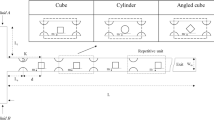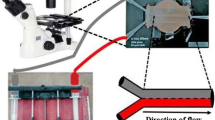Abstract
In this study, a volume of fluid (VOF) model was employed for microfluidic switch design. The VOF model validity in predicting the interface between fluid streams with different viscosities co-flowing in a microchannel was first verified by experimental observation. It was then extended to microfluidic flow switch design. Two specific flow switches, one with a guided fluid to one of five desired outlet ports, and another with a guided fluid flows into one, two, or three outlet ports equally distributed along the outlet channel of a Y-shaped channel. The flow switching was achieved by controlling the flow rate ratios between tested and buffer fluids. The numerical results showed that the VOF model could successfully predict the flow switching phenomena in these flow switches. The numerical results also showed that the flow rate ratio required for flow switching depends on the viscosity ratio between the tested and buffer fluids. The numerical simulation was verified by experimental study and the agreement was good.
Similar content being viewed by others
References
X. Bai, J. Josserand, H. Jensen, J.S. Rossier, and H.H. Girault, Anal. Chem. 74, 6205 (2002).
G. Blankenstein, L. Scampavia, J. Branebjerg, U.D. Larsen, and J. Ruzicka, u-TAS'96, Proc. 2nd Int. Symp. On Miniaturized Total Systems, Basel, Switzerland, 82 (1996).
G. Blankenstein and U.D. Larsen, Biosens. Bioelectron. 13, 427 (1998).
J.P. Brody, P. Yager, R.E. Goldstein, and R.H. Austin, Biophysical J. 71, 3430 (1996).
C. Doring, T. Grauer, J. Marek, M. Mettner, H.P. Trah, and M. William, Proc. IEEE Micro electro Mechanical Systems Workshop, MEMS'92, Travemunde, Germany, 12 (1992).
S.V. Ermakov, S.C. Jacobson, and J.M. Ramsey, Proceedings of the uTAS 2000 Symposium, Enschede, The Netherlands, 291 (2000).
FLUENT user guide (Lebanon, NH, 2002).
U. Gebhard, H. Hein, E. Just, and P. Ruther, Proc. Transducers'97, Int. Conf. on Solid-State Sensors and Acuators, Chicago, IL, USA, 761 (1997).
C.W. Hirt and B.D. Nichols, J. Comput. Phys. 29, 201 (1981).
G.B. Lee, B. Hwi, and G. Huang, J. Micromech. Microeng. 11, 654 (2001a).
G.B. Lee, C.I. Hung, B.J. Ke, G.R. Huang, and B.H. Hwei, J. Micromech. Microeng. 11, 567 (2001b).
G.B. Lee, C.I. Hung, B.J. Ke, G.R. Huang, B.H. Hwei, and H.F. Lai, ASME J. Fluids Eng. 123, 672 (2001c).
G.B. Lee, L.M. Fu, R.J. Yang, Y.J. Pan, and C.H. Lin, Transducers '03, 12th Int. Conf. Solid-state Sensors and Acuators, Boston, MA, USA, 1895 (2003).
A.V. Lemoff and A.P. Lee, Proc. Total Analysis Systems 2000, Enschede, Netherlands, 571 (2000).
A. Manz, N. Graber, and H.M. Widmer, Sensors and Actuators B1, 244 (1990).
F.G. Tseng, I.D. Yang, K.H. Lin, K.T. Ma, M.C. Lu, Y.T. Tseng, and C.C. Chieng, Sensors and Acuators A 97–98, 131 (2002).
D. Yao and B. Kim, J. Micromech. Microeng. 12, 604 (2002).
Author information
Authors and Affiliations
Corresponding author
Rights and permissions
About this article
Cite this article
Chein, R., Tsai, S.H. Microfluidic Flow Switching Design Using Volume of Fluid Model. Biomedical Microdevices 6, 81–90 (2004). https://doi.org/10.1023/B:BMMD.0000013370.86639.61
Issue Date:
DOI: https://doi.org/10.1023/B:BMMD.0000013370.86639.61




